Abstract
STUDY OBJECTIVE--The aims were (1) to identify from death certificates regions with an increased incidence of dementia mortality; and (2) to determine whether a previously observed excess of patients with Alzheimer disease originating from a small area could be confirmed in a survey of death certificates. DESIGN--The study identified all individuals dying with dementia, recorded on death certificates as an immediate, antecedent, underlying, or contributing cause of death. Rather than the usual residence, the birthplace of these individuals was used to determine regional differences in dementia mortality. A comparison was made of two areas to test the significance of a geographical isolate of persons. To test for a possible genetic component of the excess, an analysis was made of the frequencies of family names. To test for a possible environmental component an analysis was made of standard measurements of drinking water quality. SETTING--The survey data were derived from all 1985 and 1986 deaths in the province of Newfoundland. MEASUREMENTS AND MAIN RESULTS--Based on the current census population, the prevalence of dementia at death for 1985 and 1986 was 34 and 37/100,000. For both years there was a significant excess of persons originating from a small area (95% CI, 1.1-20.7%, and 2.5-20.4%). This excess could not be explained by differences in age, sex, ethnic origin, or by variation in mobility patterns. The study area has a high concentration of aluminium in the drinking water. An analysis of the family names gave inconclusive evidence of a clustering among the dementia cases. CONCLUSIONS--If all contributing causes of death are recorded and the birthplace of individuals is noted, mortality statistics can reveal regional differences in dementia rates. This shows the need to examine areas smaller than census districts to identify subpopulation variation in the prevalence of dementia. Environmental influences can vary substantially in areas relatively close together, as evidenced in measurements of drinking water chemistry. Genetic influences are more likely to be revealed from the birthplace of individuals, which may indicate a common ancestry.
Full text
PDF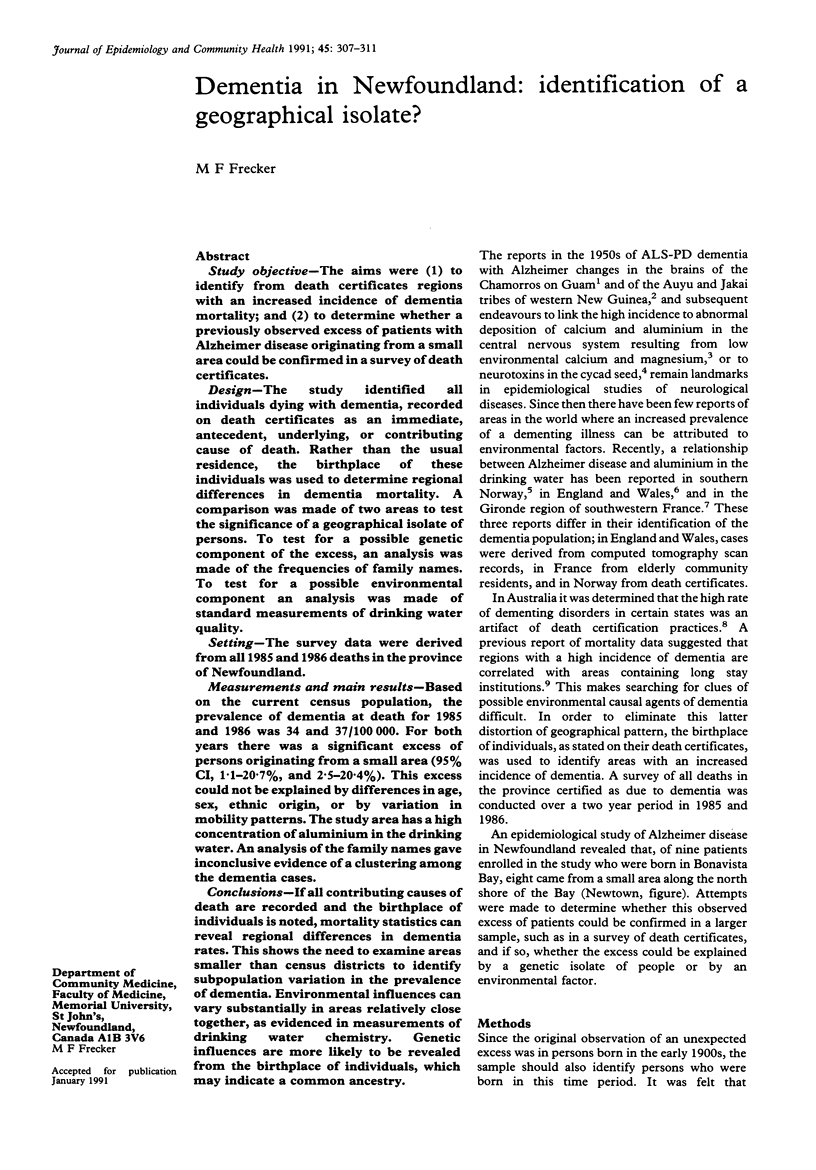
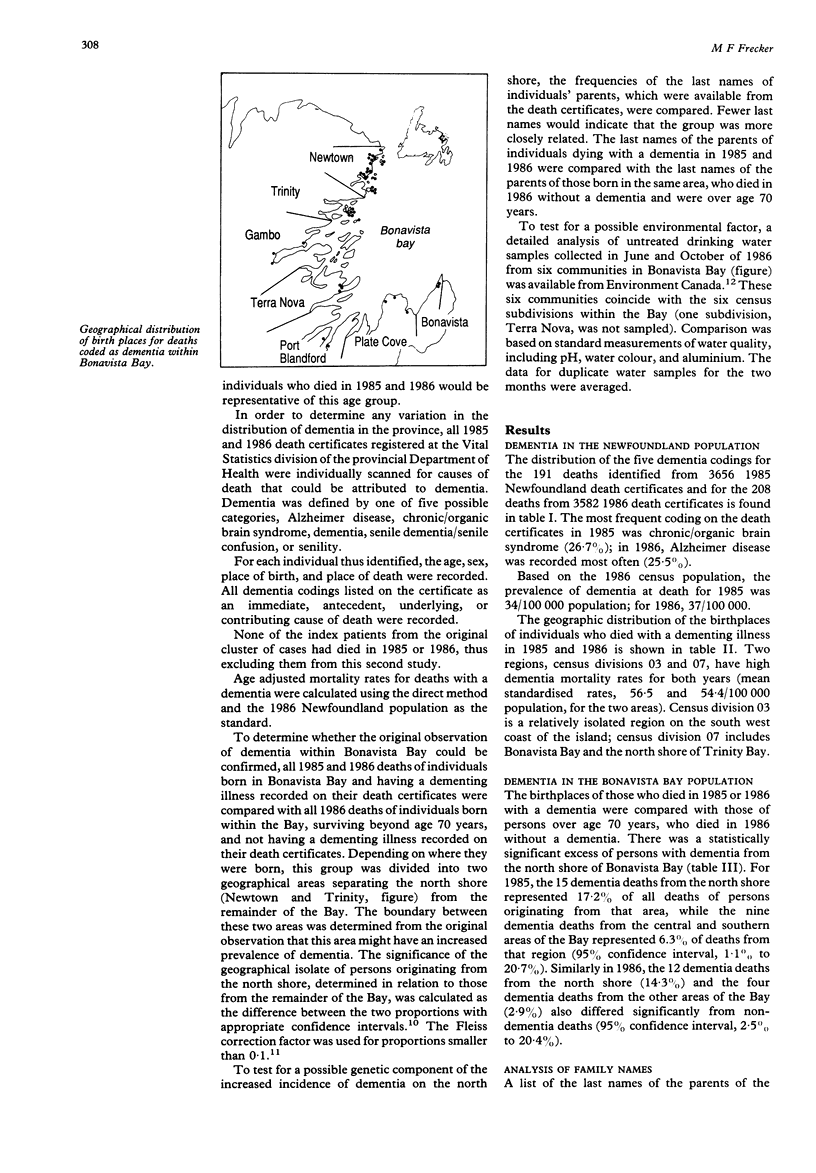
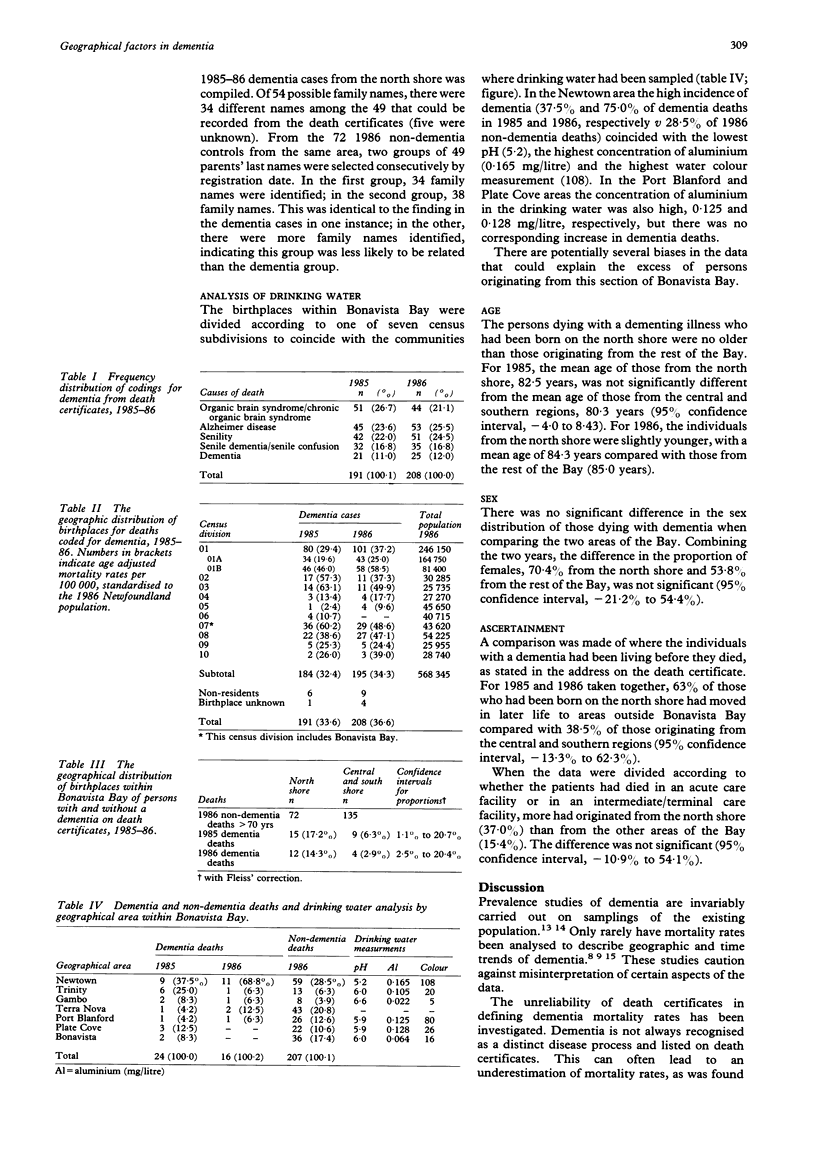
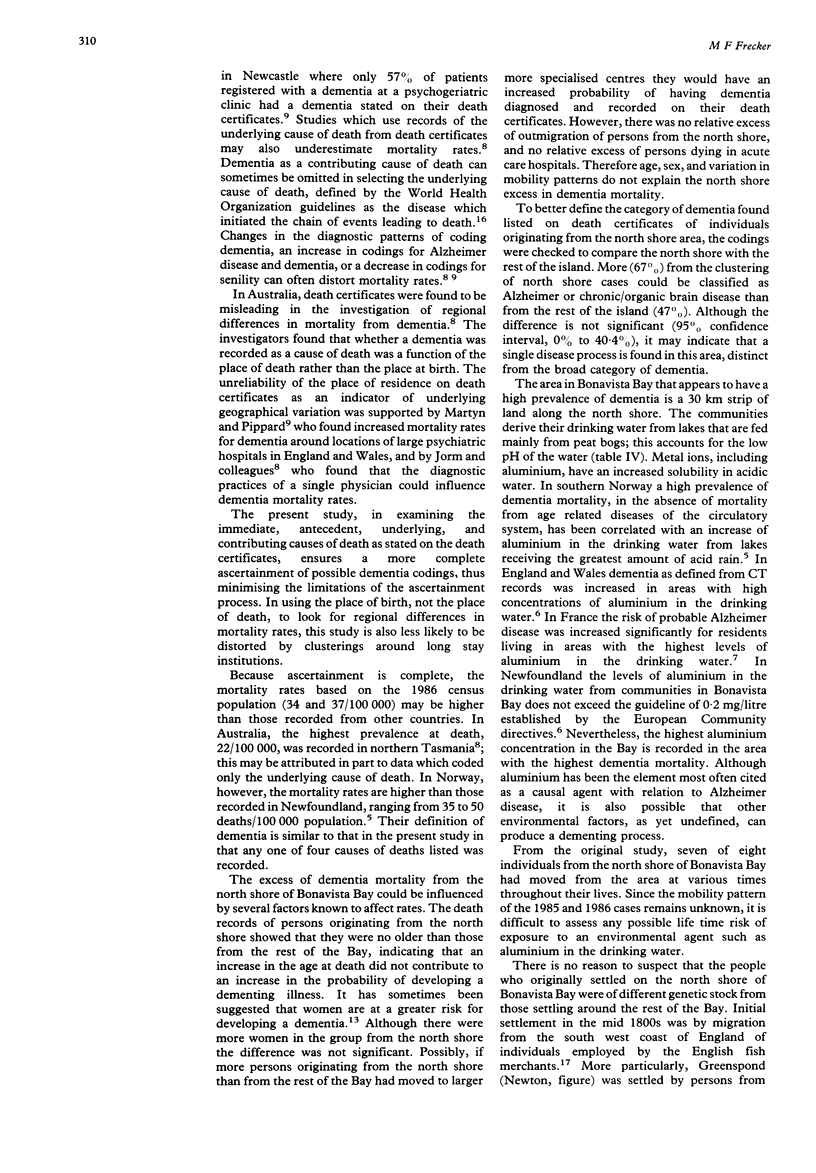
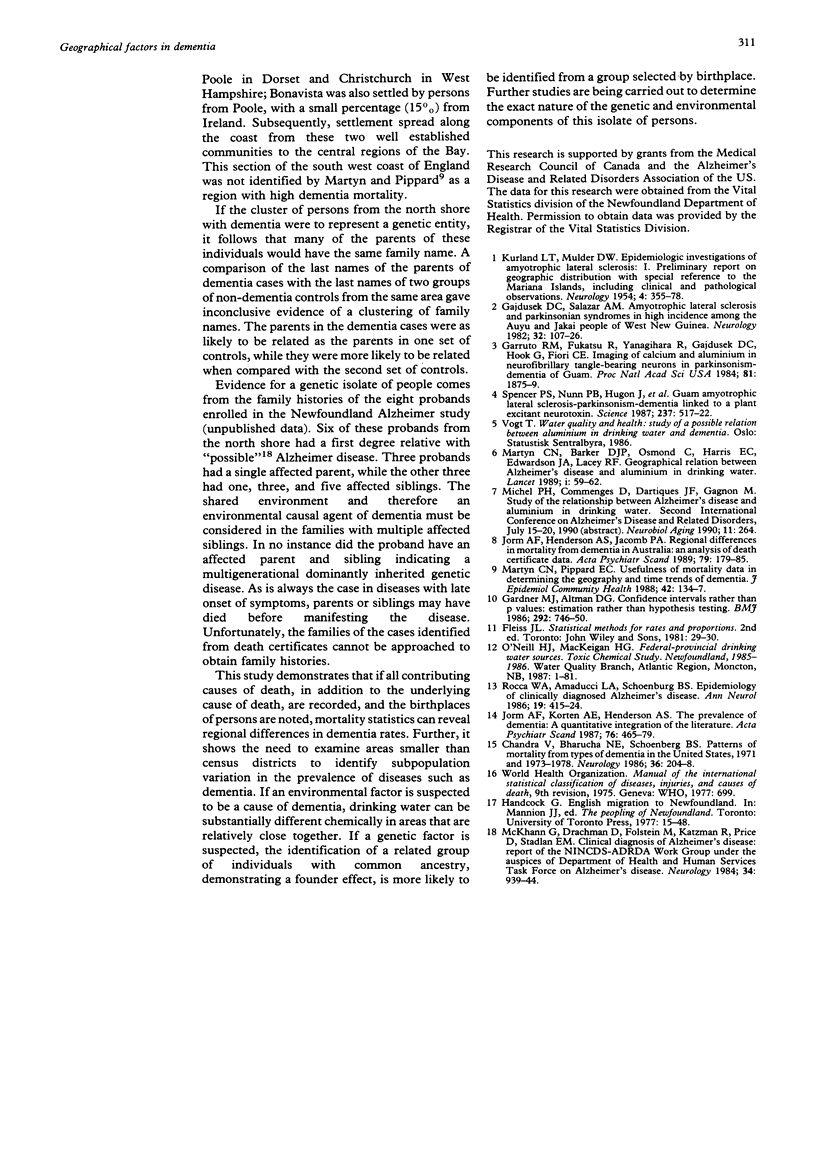
Selected References
These references are in PubMed. This may not be the complete list of references from this article.
- Chandra V., Bharucha N. E., Schoenberg B. S. Patterns of mortality from types of dementia in the United States, 1971 and 1973-1978. Neurology. 1986 Feb;36(2):204–208. doi: 10.1212/wnl.36.2.204. [DOI] [PubMed] [Google Scholar]
- Gajdusek D. C., Salazar A. M. Amyotrophic lateral sclerosis and parkinsonian syndromes in high incidence among the Auyu and Jakai people of West New Guinea. Neurology. 1982 Feb;32(2):107–126. doi: 10.1212/wnl.32.2.107. [DOI] [PubMed] [Google Scholar]
- Gardner M. J., Altman D. G. Confidence intervals rather than P values: estimation rather than hypothesis testing. Br Med J (Clin Res Ed) 1986 Mar 15;292(6522):746–750. doi: 10.1136/bmj.292.6522.746. [DOI] [PMC free article] [PubMed] [Google Scholar]
- Garruto R. M., Fukatsu R., Yanagihara R., Gajdusek D. C., Hook G., Fiori C. E. Imaging of calcium and aluminum in neurofibrillary tangle-bearing neurons in parkinsonism-dementia of Guam. Proc Natl Acad Sci U S A. 1984 Mar;81(6):1875–1879. doi: 10.1073/pnas.81.6.1875. [DOI] [PMC free article] [PubMed] [Google Scholar]
- Jorm A. F., Henderson A. S., Jacomb P. A. Regional differences in mortality from dementia in Australia: an analysis of death certificate data. Acta Psychiatr Scand. 1989 Feb;79(2):179–185. doi: 10.1111/j.1600-0447.1989.tb08585.x. [DOI] [PubMed] [Google Scholar]
- Jorm A. F., Korten A. E., Henderson A. S. The prevalence of dementia: a quantitative integration of the literature. Acta Psychiatr Scand. 1987 Nov;76(5):465–479. doi: 10.1111/j.1600-0447.1987.tb02906.x. [DOI] [PubMed] [Google Scholar]
- KURLAND L. T., MULDER D. W. Epidemiologic investigations of amyotrophic lateral sclerosis. I. Preliminary report on geographic distribution, with special reference to the Mariana Islands, including clinical and pathologic observations. Neurology. 1954 May;4(5):355–378. doi: 10.1212/wnl.4.5.355. [DOI] [PubMed] [Google Scholar]
- Martyn C. N., Barker D. J., Osmond C., Harris E. C., Edwardson J. A., Lacey R. F. Geographical relation between Alzheimer's disease and aluminum in drinking water. Lancet. 1989 Jan 14;1(8629):59–62. [PubMed] [Google Scholar]
- Martyn C. N., Pippard E. C. Usefulness of mortality data in determining the geography and time trends of dementia. J Epidemiol Community Health. 1988 Jun;42(2):134–137. doi: 10.1136/jech.42.2.134. [DOI] [PMC free article] [PubMed] [Google Scholar]
- McKhann G., Drachman D., Folstein M., Katzman R., Price D., Stadlan E. M. Clinical diagnosis of Alzheimer's disease: report of the NINCDS-ADRDA Work Group under the auspices of Department of Health and Human Services Task Force on Alzheimer's Disease. Neurology. 1984 Jul;34(7):939–944. doi: 10.1212/wnl.34.7.939. [DOI] [PubMed] [Google Scholar]
- Rocca W. A., Amaducci L. A., Schoenberg B. S. Epidemiology of clinically diagnosed Alzheimer's disease. Ann Neurol. 1986 May;19(5):415–424. doi: 10.1002/ana.410190502. [DOI] [PubMed] [Google Scholar]
- Spencer P. S., Nunn P. B., Hugon J., Ludolph A. C., Ross S. M., Roy D. N., Robertson R. C. Guam amyotrophic lateral sclerosis-parkinsonism-dementia linked to a plant excitant neurotoxin. Science. 1987 Jul 31;237(4814):517–522. doi: 10.1126/science.3603037. [DOI] [PubMed] [Google Scholar]


